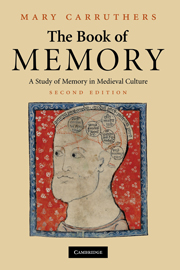Book contents
- Frontmatter
- Contents
- List of Illustrations
- Preface to the second edition
- List of Abbreviations
- Introduction
- CHAPTER 1 Models for the memory
- CHAPTER 2 Descriptions of the neuropsychology of memory
- CHAPTER 3 Elementary memory design
- CHAPTER 4 The arts of memory
- CHAPTER 5 Memory and the ethics of reading
- CHAPTER 6 Memory and authority
- CHAPTER 7 Memory and the book
- Appendix A
- Appendix B
- Appendix C
- Notes
- Bibliography
- Index of manuscripts
- General Index
Appendix C
Published online by Cambridge University Press: 05 January 2014
- Frontmatter
- Contents
- List of Illustrations
- Preface to the second edition
- List of Abbreviations
- Introduction
- CHAPTER 1 Models for the memory
- CHAPTER 2 Descriptions of the neuropsychology of memory
- CHAPTER 3 Elementary memory design
- CHAPTER 4 The arts of memory
- CHAPTER 5 Memory and the ethics of reading
- CHAPTER 6 Memory and authority
- CHAPTER 7 Memory and the book
- Appendix A
- Appendix B
- Appendix C
- Notes
- Bibliography
- Index of manuscripts
- General Index
Summary
THOMAS BRADWARDINE: “ON ACQUIRING A TRAINED MEMORY”
For a trained memory, two things are necessary, that is, stable locations and also images for the material. The locations are like tablets on which we write, the images like the letters written on them. Moreover, the locations are permanent and fixed, whereas the images are at one moment inked on like letters and at another erased. The background places must be made before the images, and so they should be treated first. With regard to these background places, six matters should be distinguished, that is, size, shape, nature, number, order, and intervening distance. Each place should be moderate in size, that is, as great as one’s visual power can comprehend in a single look, such as a little garden or the space of a small room. Indeed memory is most powerfully affected by sensory impression, and especially by vision; therefore something appears to your memory just as it ordinarily appears to your vision.
The shape of a background should be like that of a rectangle. Concerning its nature, four things should be kept in mind: to wit, that the places should not be made so dark that they cannot be recovered easily or quickly from memory, nor made overly bright, for then they will interfere with the perception of the inscribed images. Secondly, your backgrounds should not be made in a crowded place, such as a church, the market, and so forth, because the images of the things crowding such places, which would occur in a crowd in your memory, may block other images of things that you intend to place there. So images should be put into regions deserted by men and empty. Thirdly, you need to know that it is very useful if your places are real rather than only imagined or made up, for real places one can frequently inspect, and thus through repetition mentally confirm and secure their appearance. But one can work with places of one’s own imagining, if one chooses.
- Type
- Chapter
- Information
- The Book of MemoryA Study of Memory in Medieval Culture, pp. 361 - 368Publisher: Cambridge University PressPrint publication year: 2008



